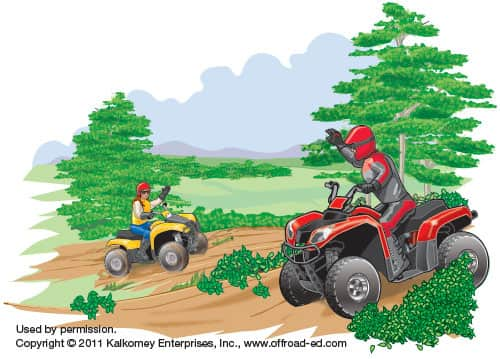A Lesson in ATV Safety Can Mean Happy Trails
Tammy Sapp 12.20.11

With 16 million Americans, including many hunters, riding all-terrain vehicles (ATVs), safety can’t take a back seat.
Like hunting, riding an ATV takes training and practice to build your skills and knowledge of how to stay safe. It’s also important to be realistic about your current skill level.
“ATV riders’ inexperience combined with an overestimation of their skills can spell trouble,” said Ed Huntsman, OHV education program manager for the Arizona Game and Fish Department. “People never expect to be on the evening news when they start out in the morning. However, if riders don’t take basic precautions, they are vulnerable to accidents.”
From 1982 to 2009, more than 10,000 people using an ATV died, according to the U.S. Consumer Product Safety Commission. Of that number, 26 percent were youths under 16 years of age. In 2009 alone, there were an estimated 131,900 ATV-related injuries, with children under the age of 16 making up 25 percent of those injured.
Fortunately, most accidents are avoidable. Huntsman advises that new and experienced riders heed the following recommendations.
- Use your head by covering it with a helmet that has a sticker confirming it complies with the U.S. Department of Transportation or Snell regulations. In addition, always wear goggles or a face shield when you ride.
- Protect yourself with a sturdy pair of gloves and over-the-ankle boots. Also, wear long-sleeve shirts, jackets and pants that offer padding for knees, shoulders and chest.
- When riding on unfamiliar or rough terrain, slow down to a speed that allows you to control your machine. In addition, be on the lookout for rocks, logs, ditches, mud and other conditions that could cause an accident.
- Riding to your hunting spot in low light conditions also can present challenges. Make sure your headlights are working and clean. Wear reflective gear so you’re more easily seen. Plus, keep a good distance from other riders, and don’t overdrive your headlight. You should be able to stop within the length of the headlight beam.
- If you’re transporting gear or game, make sure you follow the manufacturer’s guidelines and don’t overload your ATV. Make sure your headlights aren’t covered and that you can move around unrestricted. In addition, all firearms should be unloaded and fully enclosed in a gun boot or scabbard.
- Ride on designated trails, and be safe and considerate when you stop. Avoid stopping side-by-side, in the middle of the trail, at the crest of a hill, or around a corner on the trail. Also, never block an intersection. Don’t forget to shut off your engine when you take a break.
- ATVs are designed for off-road use and can be difficult to handle on paved surfaces. Riding on or crossing a road illegally or improperly is a leading cause of ATV rider fatalities. If you must cross a road, pick a spot where you can see oncoming traffic from both directions. Drive straight across when the coast is clear. Take it nice and slow and stand up for maximum visibility.
- Be weather wary. Rain, ice and snow can change trail conditions, making the ride more difficult.
- Accidents are more likely to happen at the end of the day when you’re tired. Fatigue impairs judgment and slows reaction time. Counteract that by making sure you dress for the weather, take regular breaks and stay hydrated.
- Get official training to learn how to safely and responsibly operate an ATV as well as laws and rules regulating ATV use. Many states require new riders to receive training. You can take a state-approved off-road vehicle safety course at www.offroad-ed.com.
Don’t forget these additional tips to ensure you stay safe.
- Don’t ride alone.
- Leave your travel plan and a map with a trusted family member or friend.
- Never carry a passenger on a single-rider ATV.
- Ride an ATV that’s right for your age, size, strength and skill level.
- Supervise riders younger than 16 years of age.
- Never ride under the influence of alcohol or other drugs.
ATVs are not only fun, they can be a great tool for planting food plots, traveling to your hunting area and transporting harvested game out of the woods. Taking a course at www.offroad-ed.com and then practicing your new skills is your ticket to a safe ride.
About Kalkomey
Kalkomey, parent company of www.offroad-ed.com, is the official provider of recreational safety education materials for all 50 states. Our print and Internet courses have been providing official safety certification since 1995. We provide safety courses in boating, hunting, bowhunting, and off-road vehicle (ORV) and snowmobile operation. For more information, visit http://www.kalkomey.com/.

